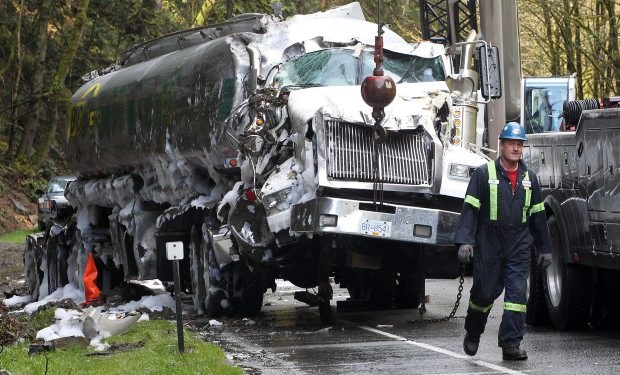An entire batch of chum salmon hit by a 2011 fuel spill in Goldstream Provincial Park have been “wiped out” and failed to return to spawn this year, a local hatchery says.
Three-year-old chum, which were directly affected as juveniles by the tanker truck crash and spill into Goldstream River, have not returned to the park this year to spawn because they likely died when the spill occurred, said Peter McCully of the Goldstream Hatchery.
“We were hoping that a number of them had escaped the effects of it, but its not looking like that’s the case,” McCully said. “It looks like that cohort was pretty much wiped out.”
About 43,000 litres of gasoline and 700 litres of diesel was spilled into Goldstream park and the river in April 2011 when a Columbia Fuels tanker truck crashed into a rock wall and flipped on its side.
“The three-year-olds would have been the ones most affected by the spill,” McCully said. “Their brood would have come into the river in 2010, laid their eggs, and then when the little ones came up out of the gravel in 2011 just at the same time as the fuel spill, that’s when they got whacked.”
After the spill, thousands of young chum were found dead in the river, foreshadowing the low numbers hatchery staff are now seeing return, he said.
“Those of us who spent time in the river knew it was a really serious event at the time,” McCully said. “It killed a lot of micro-organisms, the plankton, the algae, the whole food web was whacked.”
Despite the setback, the overall number of salmon spawning at Goldstream park this year is encouraging, he said.
Chum salmon spend three to five years in the ocean before returning to spawn, and there are encouraging returns this year for four- and five-year-old chum salmon. There are also good numbers of coho in Goldstream and other South Island watersheds, McCully said.
Coho salmon showed the effects of the fuel spill last year, when most of the tagged fish released before the spill didn’t return, McCully said. The hatchery delayed the release of other juvenile cohos for two months after the spill, and those fish did fairly well. Last year was one of the best coho returns in a decade at the park.
Columbia Fuels has spent more than $2 million in cleanup efforts at Goldstream Park. The truck driver pleaded guilty in 2012 to dangerous driving and violating the Fisheries Act and received a three-month conditional sentence, with 200 hours of community service in fish conservation.
The B.C. government continues to monitor remediation efforts at the park.
Generally, there’s little to no contamination in surface water, said Graham Knox, manager of the Ministry of Environment’s environmental emergency program. However, the concentration in groundwater occasionally exceeds provincial standards, and there remains fuel north of the spill site, he said.
“We don’t think there’s any impact on the fish or the critters,” he said. “This is something in the soil.”



